How the multi-state December tornado formed
By , Accuweather.com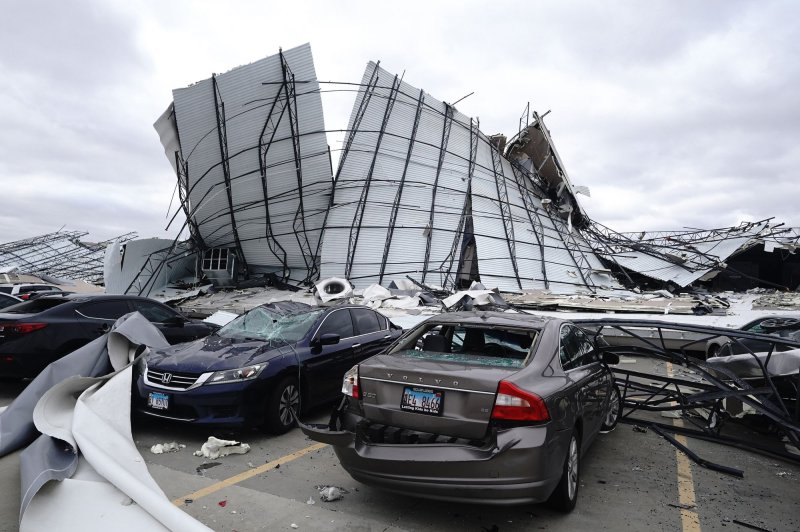
Twisted metal and chunks of concrete crushing vehicles, are all that is left of the Amazon Hub in Edwardsville, Ill., on Saturday. Photo by Bill Greenblatt/UPI | License Photo
The deadly tornado outbreak of Friday spanned multiple states in the Southeast and left hundreds of miles of devastation. With tornado outbreaks of this caliber typically occurring between February and June, many are left to wonder how such a devastating outbreak could occur in December.AccuWeather's Director of Forecast Operations, Dan Depodwin, said the outbreak that occurred in the Southeast was "a very rare situation."
"We talk about these types of events with numerous tornadoes...several violent with what appears to be violent EF4 or maybe EF5 tornadoes. Those typically occur in the spring time in the February through June time frame in most cases," said Depodwin.
Severe weather can happen this time of year, but Depodwin says it's typically confined to the Gulf Coast region and sometimes a bit further north compared to the outbreak that just occurred in the Southeast.
"I think what really surprised me...and struck most of the weather community about this outbreak yesterday was how far north they came and how violent the tornadoes were," he said.
An average of two dozen or so tornadoes are reported in the United States during the month of December. The multi-state outbreak is shaping up to be much more than average and much farther north than usual. In addition, the number of fatalities that the outbreak may have caused is exceptionally rare, as the month of December rarely sees tornado fatalities at all.
The unusual warmth in the north that preceded the outbreak was one of the main ingredients that drove it to occur. It's typically not so warm this time of year for that region, so outbreaks are usually unable to form.
"I think the warm December certainly played a role. We haven't had a lot of cold fronts make their way all the way down into the Gulf of Mexico yet so that can sometimes help cool off the sea surface temperatures," said Depodwin.
The Gulf of Mexico being at or above normal this time of year can further aid in the transport of warmer air northward, which is what helped fuel the multi-state outbreak seen Friday.
As the warmer air from the gulf moved north, a very strong low pressure area was moving out of the Rockies and into the Great Lakes region. This pulled the warm and moist air north.
Depodwin said the four main ingredients for severe weather were prevalent to create the outbreak.
"You need moisture, which we had from the Gulf of Mexico. You need instability, rising air. You need colder air aloft, we had that. You need some type of lifting mechanism, a cold front in this case. And then you need some type of turning in the atmosphere or windshield, as we call it," he explained.
All four ingredients have to come together perfectly to have a strong outbreak, as they did on Friday.
"This sort of reminded me of a March or April type setup, certainly something we don't see often at all. In December...we talk about December here. We don't typically have a lot of warm air," he said.
As for later this month, the potential for severe weather continues to exist. Next week will see a storm eject from the Rockies, bringing more warm moist air north. That air will collide with colder air to the north, creating a severe weather threat.
The spots to watch for that potential severe weather outbreak will include portions of northern Missouri, Iowa and potentially parts of southern Minnesota.
"If you live in any parts of the middle of the country here or the Mississippi Valley in the next week or so, we have to keep an eye on one or two chances for severe weather. And then, as we head more into January, we typically see a low in the severe weather before it ramps back up," said Depodwin.
As for the possibility for another outbreak like last Friday night, Depodwin says it's unlikely.
"There can certainly be more tornadoes this month, though," he said.
Severe weather 'new normal,' US emergency chief warns after tornadoes

Severe weather events -- like the huge tornadoes which caused dozens of deaths and catastrophic damage across multiple US states -- are becoming more common as a result of climate change, US officials warn (AFP/Brendan Smialowski)
Sun, December 12, 2021,
More powerful, destructive, and deadlier storms will be the "new normal" as the effects of climate change take root, the top US emergency management official said Sunday after massive tornadoes ravaged six states.
Meteorologists and other scientists have long warned of the growing intensity of weather events like storms, fires and flooding.
But the crisis hit home in a terrifying way overnight Friday into Saturday when more than two dozen twisters raked across large swaths of the American heartland, leaving more than 90 people dead, dozens missing and communities in ruin.
"This is going to be our new normal," Deanne Criswell, head of the Federal Emergency Management Agency, told CNN's "State of the Union" as she did a round of national Sunday morning talk shows before she headed to Kentucky to assess the damage and help coordinate the federal response.
"The effects that we're seeing from climate change are the crisis of our generation," the FEMA chief added.
Criswell warned of the challenge that the United States faces in addressing such severe weather events.
"We're seeing more intense storms, severe weather, whether it's hurricanes, tornadoes, wildfires," she said on ABC's "This Week."
"The focus I'm going to have is, how do we start to reduce the impacts of these events?"
The tornado that reduced several towns to rubble was a gargantuan twister. It rumbled along the ground for over 200 miles (320 kilometers), one of the longest, if not the longest, on record.
US President Joe Biden said Saturday the storm system was likely "one of the largest tornado outbreaks in our history."
And while he stressed that the impact of climate change on these particular storms was not yet clear, "we all know everything is more intense when the climate is warming -- everything."
Scientists have stopped short of conclusive determinations that more violent storms are the result of climate change, but they agree that evidence is building.
One paper published recently by scientific association AGU says its analysis "suggests increasing global temperature will affect the occurrence of conditions favorable to severe weather."
Daniel Swain, a UCLA climate scientist, tweeted Saturday in response to the study, saying that while the effect of climate change on severe weather like tornadoes is not well established, "there is a growing body of research (including this late-breaking paper) suggesting that warming likely does increase such risks in many regions globally."
mlm/bbk
The Perfect Storm — part two, three, four...
/ Earth & Energy/ Climate Change/ Extreme Weather/ Global Warming
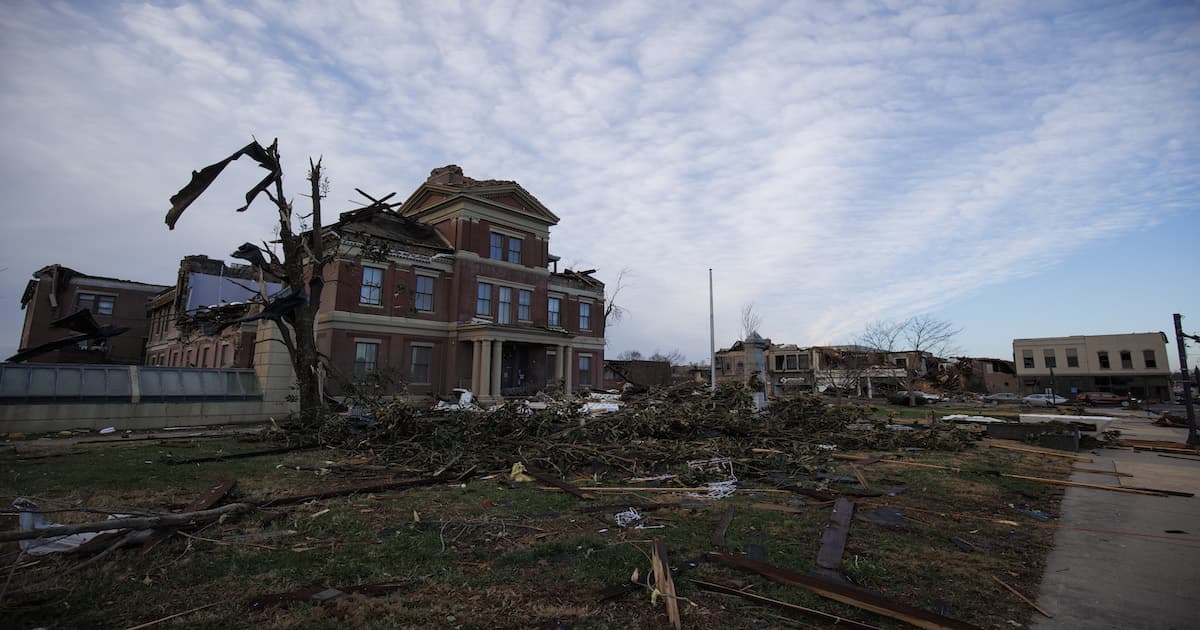
Image by Getty
After horrific tornadoes devastated thousands of homes and killed dozens across Illinois, Kentucky, and Tennessee, experts are warning that climate change could be making the fearsome storms stronger.
“As last night showed severe tornadoes can happen in any season, especially if the weather is unusually warm, as it was last night,” said Dr. Robert Rohde, lead scientist at Berkeley Earth, on Twitter Saturday morning.
“Historically, December has the fewest tornadoes in the USA,” Rohde added.
Rohde isn’t alone in noticing how unseasonably warm the December evening was, and multiple other scientists say climate change could have aggravated the storms. A new report from the Washington Post gathered insights from numerous scientists who say that unfortunately, storms like this may become more common and should be further researched.
“A lot of people are waking up today and seeing this damage and saying, ‘Is this the new normal?'” Victor Gensini, a meteorology professor at Northern Illinois University told the Post. “It’ll be some time before we can say for certain what kind of role climate change played in an event like yesterday.”
The warmer the air and the colder the cold front that clashes into it, the more turbulent and violent the storms become. Temperatures in the tornado’s path helped created a more powerful storm, according to WaPo, rising into the 70s to near 80 degrees Friday evening. In Memphis, a 103-year-old record high was broken when temperatures hit 79 degrees Farenheit.
“It’s absolutely fair to say that the atmospheric environments will be more supportive for cool-season tornado events,” Gensini told the Post.
However, that doesn’t mean there’s a definite link between climate change and worsening tornados, and scientists say we still have more to learn.
“Tornadoes are, unfortunately, one of the extreme events where we have the least confidence in our ability to attribute or understand the impact of climate change on specific events,” Zeke Hausfather, climate scientist at the Breakthrough Institute, in Oakland, CA told the Post. “There is not much evidence to date that the number of strong tornadoes is different today than it was over much of the past century.”
Although scientists may need more time to figure out just how tornadoes may be changing, if at all, residents in other parts of the country know personally how the damage sticks around long after buildings are repaired and power is restored.
On Friday evening, residents of Nashville, TN took to Twitter to talk about surviving the devastating March 2020 tornado that killed two and decimated entire blocks of historic music venues and bars. Many also shared photos of their tornado safety planning and shared how anxious they remained during this weekend’s storm.
“Not sure I’ve ever stayed up this late,” tweeted Tennessee-based news editor Holly McCall, echoing the thoughts of many Nashvillians.
Even if it takes scientists years to catch up, people in the South and Midwest know firsthand how devastating these storms are, and many say they’ve never seen anything like it. Although it’s traumatizing and hard to admit, back-to-back years with high tornado death tolls means it may be a matter of time until data catches up with what everyday people seem to already believe: the weather feels like it’s getting worse.
More on climate trouble: Scientists Are Building a “Black Box” to Record End of Civilization
Warm weather was a crucial ingredient in the outbreak that killed dozens of people, but whether climate change is a factor is not quite as clear.
AP
12/12/2021
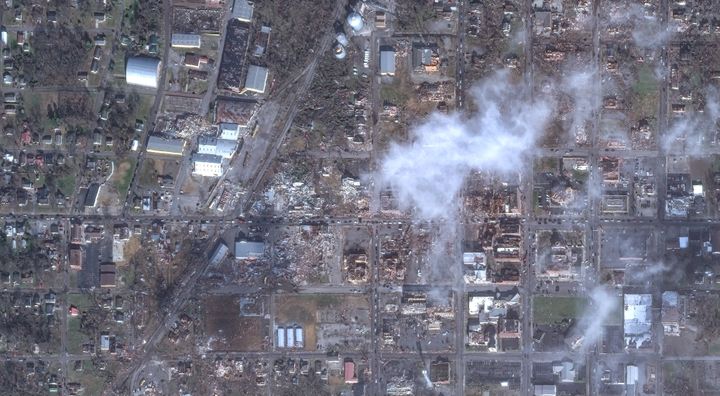
Satellite imagery shows Mayfield, Kentucky, after a tornado hit the town on Friday.
MAXAR VIA GETTY IMAGES
WASHINGTON (AP) — The calendar said December but the warm moist air screamed of springtime. Add an eastbound storm front guided by a La Nina weather pattern into that mismatch and it spawned tornadoes that killed dozens over five U.S. states.
Tornadoes in December are unusual, but not unheard of. But the ferocity and path length of Friday night’s tornadoes likely put them in a category of their own, meteorologists say. One of the twisters — if it is confirmed to have been just one — likely broke a nearly 100-year-old record for how long a tornado stayed on the ground in a path of destruction, experts said.
“One word: remarkable; unbelievable would be another,” said Northern Illinois University meteorology professor Victor Gensini. “It was really a late spring type of setup in in the middle of December.”
Warm weather was a crucial ingredient in this tornado outbreak, but whether climate change is a factor is not quite as clear, meteorologists say.
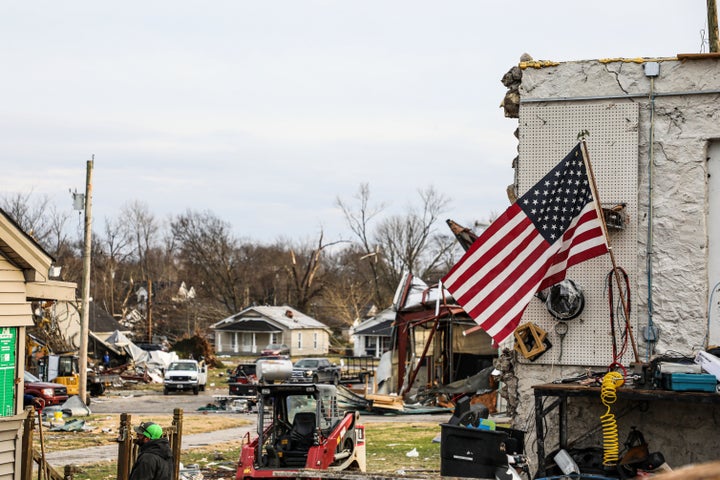
A U.S. national flag waves among tornado damage after extreme weather hit the region in Bowling Green, Kentucky.
GUNNAR WORD VIA GETTY IMAGES
Scientists say figuring out how climate change is affecting the frequency of tornadoes is complicated and their understanding is still evolving. But they do say the atmospheric conditions that give rise to such outbreaks are intensifying in the winter as the planet warms. And tornado alley is shifting farther east away from the Kansas-Oklahoma area and into states where Friday’s killers hit.
Here’s a look at what’s known about Friday’s tornado outbreak and the role of climate change in such weather events.
WHAT CAUSES A TORNADO?
Tornadoes are whirling, vertical air columns that form from thunderstorms and stretch to the ground. They travel with ferocious speed and lay waste to everything in their path.
Thunderstorms occur when denser, drier cold air is pushed over warmer, humid air, conditions scientists call atmospheric instability. As that happens, an updraft is created when the warm air rises. When winds vary in speed or direction at different altitudes — a condition known as wind shear — the updraft will start to spin.
These changes in winds produce the spin necessary for a tornado. For especially strong tornadoes, changes are needed in both the wind’s speed and direction.
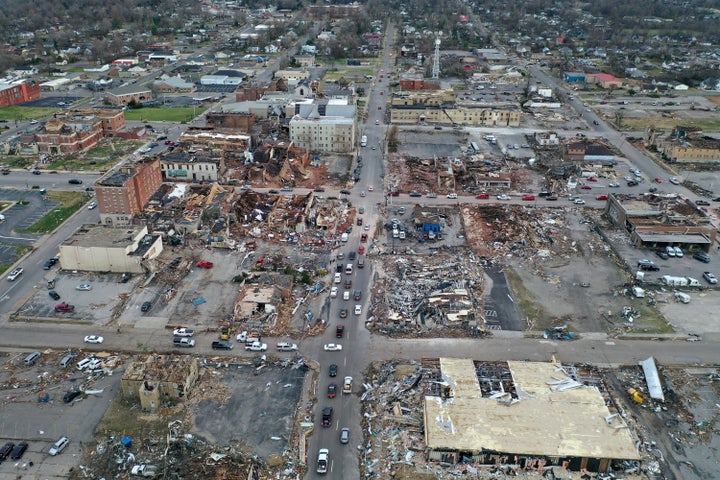
Warm weather was a crucial ingredient in this recent tornado outbreak, but whether climate change is a factor is not quite as clear, meteorologists say.
SCOTT OLSON VIA GETTY IMAGES
“When considerable variation in wind is found over the lowest few thousand feet of the atmosphere, tornado-producing ‘supercell thunderstorms’ are possible,” said Paul Markowski, professor of meteorology at Pennsylvania State University. “That’s what we had yesterday.”
There’s usually a lot of wind shear in the winter because of the big difference in temperature and air pressure between the equator and the Arctic, Gensini said.
But usually, there’s not a lot of instability in the winter that’s needed for tornadoes because the air isn’t as warm and humid, Gensini said. This time there was.
WHAT CONDITIONS LED TO STORMS OF THIS SCALE?
A few factors, which meteorologists will continue to study.
Spring-like temperatures across much of the Midwest and South in Decem
Tornadoes typically lose energy in a matter of minutes, but in this case it was hours, Gensini said. That’s partly the reason for the exceptionally long path of Friday’s storm, going more than 200 miles (322 kilometers) or so, he said. The record was 219 miles (352 kilometers) and was set by a tornado that struck four states in 1925. Gensini thinks this one will surpass it once meteorologists finish analyzing it.
“In order to get a really long path length, you have to have a really fast moving storm. This storm was moving well over 50 miles (80 kilometers) per hour for a majority of its life,” Gensini said. That’s not the speed of the winds, but of the overall storm movement.
“You’re talking about highway-speed storm motions,” Gensini said.
HOW RELATED IS CLIMATE CHANGE TO TORNADO OUTBREAKS?
It’s complicated. Scientists are still trying to sort out the many conflicting factors about whether human-caused climate change is making tornadoes more common — or even more intense. About 1,200 twisters hit the U.S. each year — though that figure can vary — according to the NOAA National Severe Storms Laboratory. No other country sees as many.
Attributing a specific storm like Friday’s to the effects of climate change remains very challenging. Less than 10% of severe thunderstorms produce tornadoes, which makes drawing conclusions about climate change and the processes leading up to them tricky, said Harold Brooks, a tornado scientist at the National Severe Storms Laboratory.
Scientists have observed changes taking place to the basic ingredients of a thunderstorm, however, as the planet warms. Gensini says in the aggregate, extreme storms are “becoming more common because we have a lot warmer air masses in the cool season that can support these types of severe weather outbreaks.”
The U.S. is likely to see more tornadoes occur in the winter, Brooks said, as national temperatures rise above the long-term average. Fewer events will take place in the summer, he said.
Furtado of the University of Oklahoma said tornado alley, a term used to describe where many twisters hit the U.S., has shifted eastward into the Mississippi River Valley. That shift is because of increases in temperature, moisture and shear.
“Bottom line: The people in the Mississippi River Valley and Ohio River Valley are becoming increasingly vulnerable to more tornadic activity with time,” he said.
Follow Suman Naishadham on Twitter @sumannaishadham and Seth Borenstein at @borenbears
The Associated Press receives support from the Walton Family Foundation for coverage of water and environmental policy. The AP is solely responsible for all content. For all of AP’s environmental coverage, visit https://apnews.com/hub/environment
No comments:
Post a Comment